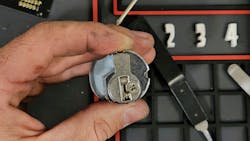Dive into the Inner Workings of the Schlage Primus
Let’s take an inside look at the Schlage Primus patented keyway. It is the added complexity of this system that makes it high security.
The standard Schlage classic keyway has only one shearline of pins at the top. Six pins make up one singular shearline. The Schlage Everest 29 keyway is the next grade up. It involves an extra check pin and a different key blank than the standard Schlage SC. However, it doesn’t offer the higher level of complexity of the Schlage Primus. Schlage Primus offers a completely separate, independent shearline from the sidebar and the top pins.
Taking It Apart
We are going to take a look inside the Primus cylinder (Photo 1) by pulling it apart by taking the back cam screw off.
This cutaway (photo 2) provides an excellent example of how this lock actually works. From this angle (photo 3), it looks like a convention pin tumbler lock. However, on the other side (photo 4), you can see how the finger pins engage with the sidebar and then how the finger pins engage with the side milling (photo 5) that is on the key blank itself.
In photo 6, the sidebar is removed and you can see the tiny sidebar springs (very easy to lose). Make sure you keep track of all of those springs.
As long as the key blank stays inserted, the finger pins will stay in place. If you need to change the finger pin arrangement, you’ll have to remove the key blank slowly and release each one of the pins and springs for the finger pins, one by one.
When you’re reloading and rebuilding the cylinder, you put the spring in first and then put the finger pin in second and then insert the key to hold and trap it in place. All these tiny little parts make this an ultra-complex lock.
Photo 7 shows a springe removed and Photo 8 shows the underside of one of the finger pins and how the pins engage with the sidebar.
Because I’m using a demo model (Photo 9), you can see the sidebar and a finger pin encased in acrylic to demonstrate how the system works.
When rebuilding this cutaway lock cylinder, you’ll have to trap one of the top pins just like you would rebuilding a conventional cylinder using the follower and a set of tweezers.
Photo 10 shows the plug fully removed and all of the parts taken out of the plug as well. It’s been fully field-stripped.
Primus is very proud of their locks. You will always recognize the big “PRIMUS” stamped right on the face of the lock cylinder.
Putting It Back Together
Photo 11 shows the housing or the bible of the lock, completely field-stripped as well, so we can begin servicing this lock and putting it back together. You can see all those tiny little parts on my pinning tray (Photo 12).
The sidebar is what makes this lock very pick-resistant. You need specialized key blanks with that side milling
With Schlage Primus, the cuts coincide with the depth of the finger pins so the sidebar doesn’t change. The pins and the way they engage with the key, much like they engage with the cuts on the top of the key, these engage with the cuts on the side of the key.
A top for rekeying: it helps to hold the finger pins in place. They are going to try and dump out of there now and when you load the key pins as well. However, if you insert the key and engage the finger pins in the side milling, it holds it in place so you can continue to put springs and load the finger pins in place.
To rebuild the cylinder, I’ll start with the top spring and the follower and rebuild as you would a conventional lock. As far as the finger pins go, those get rebuilt through the cylinder itself.
For information from Schlage, go to https://commercial.schlage.com/en/products/key-systems/primus-security-upgrade.html.
Wayne Winton is the owner of Tri-County Locksmith Services, located in Glenwood Springs, Colorado. For more information, check out Wayne’slockshop.com.
About the Author
Wayne Winton
Wayne Winton is the owner of Tri-County Locksmith Services, located in Glenwood Springs, Colorado.
